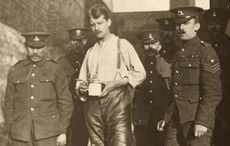Archaeologists have set out to discover whether hundreds of Spanish Armada sailors are buried on a plot of land near Dunluce Castle on Northern Ireland’s Causeway Coast.
According to legend, more than 200 Spanish sailors were buried in an ancient graveyard surrounding the ruins of St Cuthbert’s, a church dating back to the 13th century. It is said the sailors were given a Christian burial after their bodies washed up on the coast when the La Girona warship sank in 1588. Of the 1,300 on board the La Girona, only nine survived.
The 50 gun galley was smashed on rocks off Lacada Point near the landmark Giant's Causeway and bodies of many of the drowned men washed ashore along the coastline.
The Daily Mail reports that archaeologists from Stormont's Department of the Environment plan to conduct a geophysical survey of a large unmarked plot in the graveyard to determine if it was used as a mass burial site for the Armada's victims.
Andrew Gault, one of the DoE archaeologists working on the project, said: “There would have been hundreds of bodies washed up along this coastline and the local tradition is a lot of them were buried in St Cuthbert's graveyard and there's a specific area of the graveyard where local tradition would say that took place.”
“We can see there's a very conspicuous area within the graveyard where there weren't any headstones erected and it's fairly regular and rectangular in shape and it's quite sunken and hollow.
“So that's a bit of smoking gun as to where you would expect if there was a mass grave to be it would be in that type of location.
“So we are hoping to do some further investigation in the future using geophysical survey, which is a non-destructive non-intrusive technique, to see whether there is evidence of actually a big burial cut, a big grave cut in that area.
“That will help to firm up exactly whether there is a Spanish Armada era grave in that location - so that's a really interesting part of the site's story.”
The archaeological survey is part of a wider project to unearth the lost history of Dunluce.




Comments